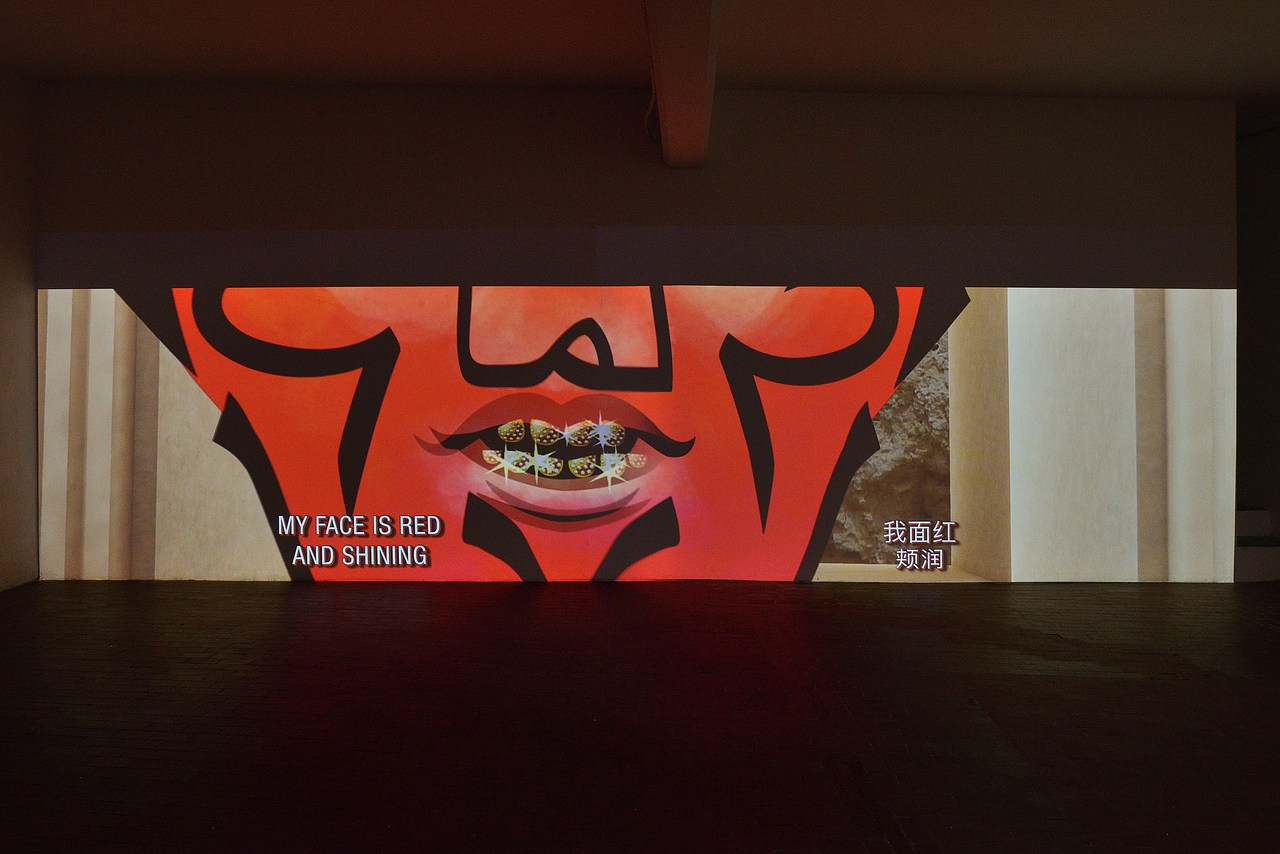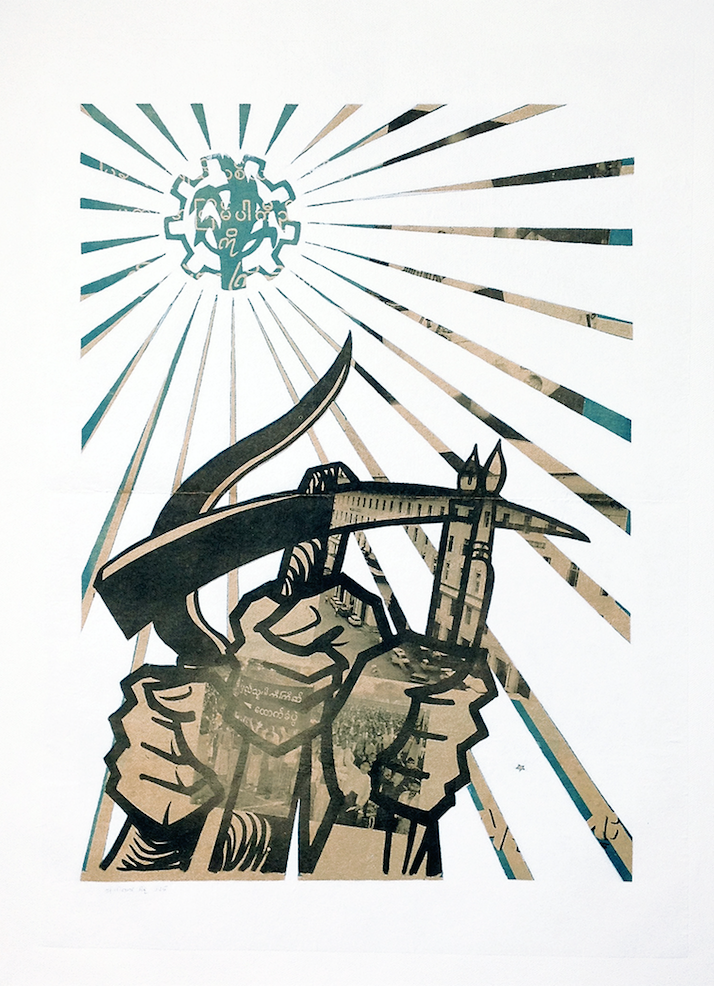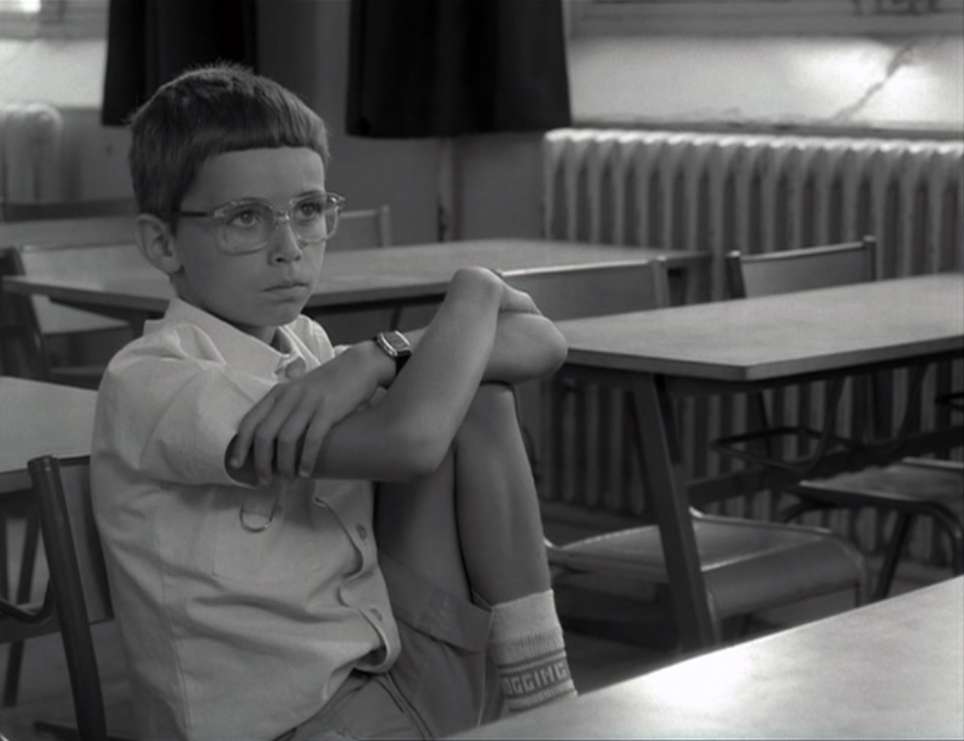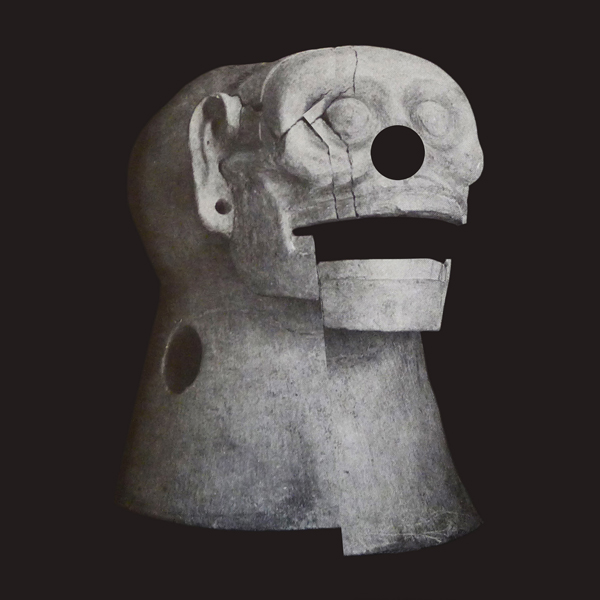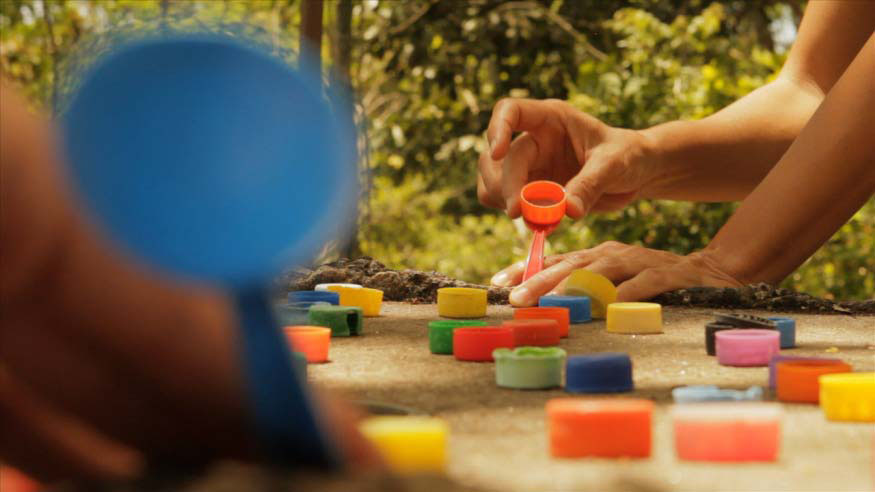
© » KADIST
Musquiqui Chihying and Gregor Kasper
Addressing the legacy of colonialism, The Guestbook by Musquiqui Chihying and Gregor Kasper is a slow-paced, black-and-white film exploring the German colony of Togoland, now the Republic of Togo. The guestbook in question—a thin, battered copy that Do Do, the Togolese protagonist of the film, finds in Berlin’s State Library—is filled with the signatures of colonial-era explorers. The plot follows Do Do as he seeks out Treptower Park, where the JAZZ musician Kwassi Bruce was once exhibited in a human zoo in the first German Colonial Exhibition.

© » KADIST
Musquiqui Chihying
The Sculpture by Musquiqui Chihying comprises a two-channel lecture performance and a photograph. The video begins with 2017 footage of French president Emmanuel Macron announcing his commitment to the restitution of French-held African objects looted during the colonial era. Moving through the video, the artist’s voice narrates over archival images and videos, explaining how so many African artifacts came into the possession of European museums.
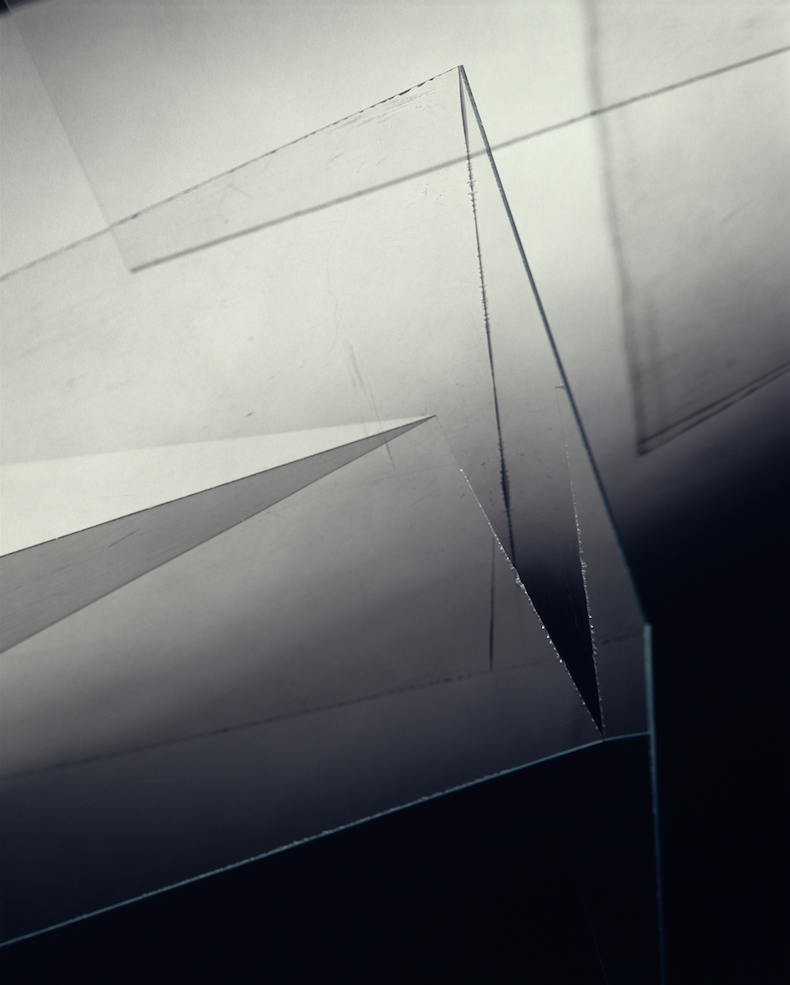
© » KADIST
Barbara Kasten
Barbara Kasten’s Studio Construct 51 depicts an abstract still life: a greyscale photograph of clear translucent panes assembled into geometric forms, the hard lines of their edges converging and bisecting at various points. Light streams from unseen sources and projects rectangular shadows against an adjacent wall. Three-dimensional shapes become suddenly flat as the objects in Kasten’s still life are juxtaposed alongside their ghostly traces.

© » KADIST
Gregory Halpern
Gregory Halpern spent five years shooting ZZYZX , and another year editing the results, from an estimated thousand rolls of film, about half of which were shot in the final year after his Guggenheim Fellowship enabled him to live in California. According to Halpern, the series “is grounded in reality, but it occupies an in-between space, between documentary and a certain sense of mystery.” …“I see ZZYZX as part of a continuum but edging a little closer towards fiction.” The series title is borrowed from the village Zzyzx (pronounced zye-zix), formerly Soda Springs, but rechristened by the mineral water pioneer, Curtis Howe Springer, in 1944. The eccentric Springer named it after what he claimed to be the last word in the English language.

© » KADIST
Gregory Halpern
Gregory Halpern spent five years shooting ZZYZX , and another year editing the results, from an estimated thousand rolls of film, about half of which were shot in the final year after his Guggenheim Fellowship enabled him to live in California. According to Halpern, the series “is grounded in reality, but it occupies an in-between space, between documentary and a certain sense of mystery.” …“I see ZZYZX as part of a continuum but edging a little closer towards fiction.” The series title is borrowed from the village Zzyzx (pronounced zye-zix), formerly Soda Springs, but rechristened by the mineral water pioneer, Curtis Howe Springer, in 1944. The eccentric Springer named it after what he claimed to be the last word in the English language.

© » KADIST
Gregory Halpern
Gregory Halpern spent five years shooting ZZYZX , and another year editing the results, from an estimated thousand rolls of film, about half of which were shot in the final year after his Guggenheim Fellowship enabled him to live in California. According to Halpern, the series “is grounded in reality, but it occupies an in-between space, between documentary and a certain sense of mystery.” …“I see ZZYZX as part of a continuum but edging a little closer towards fiction.” The series title is borrowed from the village Zzyzx (pronounced zye-zix), formerly Soda Springs, but rechristened by the mineral water pioneer, Curtis Howe Springer, in 1944. The eccentric Springer named it after what he claimed to be the last word in the English language.

© » KADIST
Gregory Halpern
Gregory Halpern spent five years shooting ZZYZX , and another year editing the results, from an estimated thousand rolls of film, about half of which were shot in the final year after his Guggenheim Fellowship enabled him to live in California. According to Halpern, the series “is grounded in reality, but it occupies an in-between space, between documentary and a certain sense of mystery.” …“I see ZZYZX as part of a continuum but edging a little closer towards fiction.” The series title is borrowed from the village Zzyzx (pronounced zye-zix), formerly Soda Springs, but rechristened by the mineral water pioneer, Curtis Howe Springer, in 1944. The eccentric Springer named it after what he claimed to be the last word in the English language.

© » KADIST
Gregory Halpern
Gregory Halpern spent five years shooting ZZYZX , and another year editing the results, from an estimated thousand rolls of film, about half of which were shot in the final year after his Guggenheim Fellowship enabled him to live in California. According to Halpern, the series “is grounded in reality, but it occupies an in-between space, between documentary and a certain sense of mystery.” …“I see ZZYZX as part of a continuum but edging a little closer towards fiction.” The series title is borrowed from the village Zzyzx (pronounced zye-zix), formerly Soda Springs, but rechristened by the mineral water pioneer, Curtis Howe Springer, in 1944. The eccentric Springer named it after what he claimed to be the last word in the English language.
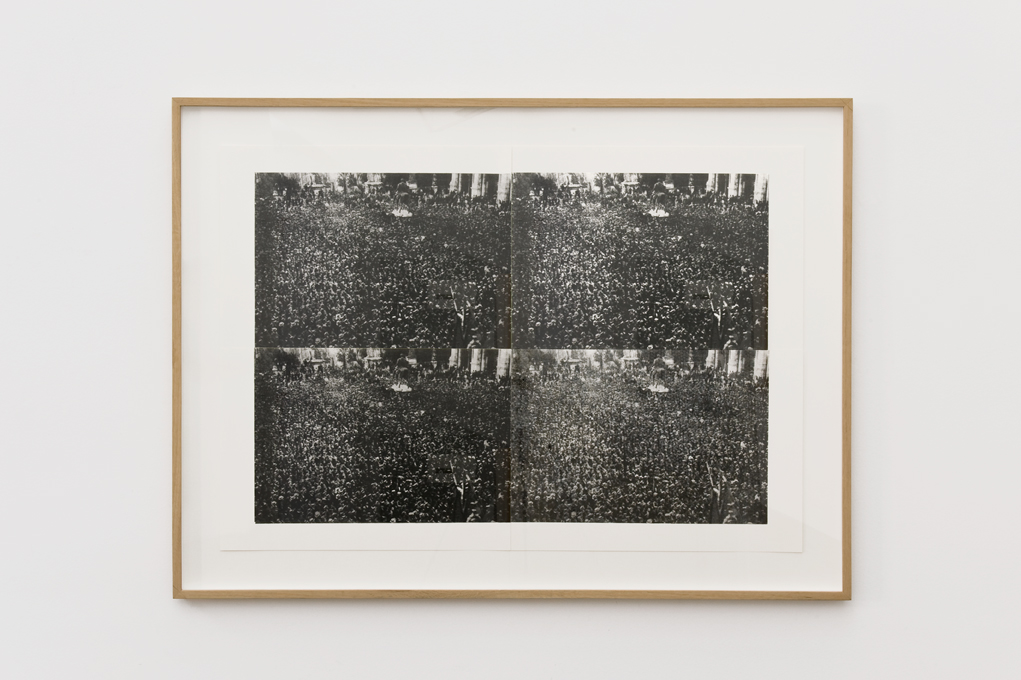
© » KADIST
Asier Mendizabal
Rotation presents the image of a crowd, a re-appropriation of 19th or beginning of 20th century photographs published in newspapers and magazines. This artwork is composed of the same image repeated four times with different resolutions. The last image in Rotation is less focused than the original one.

© » KADIST
Caspar Heinemann
Glorie #7 by Caspar Heinemann is made from cardboard boxes in which the artist received deliveries at home during lockdown, as well as other materials that he uses in an improvisatory way. Initially, Heinemann began this project by wanting to make a series of birdhouses, an interest of his that derived from walking in parks during lockdown, when bird life was so much more present as a result of the reduction in traffic noise and the absence of aircrafts. Though birdhouses may be safe spaces to nurture fledglings, they are also inherently absurd, as human constructs projected onto bird life.

© » KADIST
Gregory Crewdson
Forest Gathering N.2 is part of the series of photographs Beneath the Roses (2003-2005) where anonymous townscapes, forest clearings and broad, desolate streets are revealed as sites of mystery and wonder; similarly, ostensibly banal interiors become the staging grounds for strange human scenarios. These scenes are tangibly atmospheric, visually alluring and often deeply disquieting. Never anchored precisely in time or place, these and the other narratives of Beneath the Roses are rather located in the dystopic landscape of the anxious American imagination.

© » KADIST
Gregory Halpern
Gregory Halpern spent five years shooting ZZYZX , and another year editing the results, from an estimated thousand rolls of film, about half of which were shot in the final year after his Guggenheim Fellowship enabled him to live in California. According to Halpern, the series “is grounded in reality, but it occupies an in-between space, between documentary and a certain sense of mystery.” …“I see ZZYZX as part of a continuum but edging a little closer towards fiction.” The series title is borrowed from the village Zzyzx (pronounced zye-zix), formerly Soda Springs, but rechristened by the mineral water pioneer, Curtis Howe Springer, in 1944. The eccentric Springer named it after what he claimed to be the last word in the English language.

© » KADIST
Gregory Halpern
Gregory Halpern spent five years shooting ZZYZX , and another year editing the results, from an estimated thousand rolls of film, about half of which were shot in the final year after his Guggenheim Fellowship enabled him to live in California. According to Halpern, the series “is grounded in reality, but it occupies an in-between space, between documentary and a certain sense of mystery.” …“I see ZZYZX as part of a continuum but edging a little closer towards fiction.” The series title is borrowed from the village Zzyzx (pronounced zye-zix), formerly Soda Springs, but rechristened by the mineral water pioneer, Curtis Howe Springer, in 1944. The eccentric Springer named it after what he claimed to be the last word in the English language.

© » KADIST
Gregory Halpern
Gregory Halpern spent five years shooting ZZYZX , and another year editing the results, from an estimated thousand rolls of film, about half of which were shot in the final year after his Guggenheim Fellowship enabled him to live in California. According to Halpern, the series “is grounded in reality, but it occupies an in-between space, between documentary and a certain sense of mystery.” …“I see ZZYZX as part of a continuum but edging a little closer towards fiction.” The series title is borrowed from the village Zzyzx (pronounced zye-zix), formerly Soda Springs, but rechristened by the mineral water pioneer, Curtis Howe Springer, in 1944. The eccentric Springer named it after what he claimed to be the last word in the English language.

© » KADIST
Gregory Halpern
Gregory Halpern spent five years shooting ZZYZX , and another year editing the results, from an estimated thousand rolls of film, about half of which were shot in the final year after his Guggenheim Fellowship enabled him to live in California. According to Halpern, the series “is grounded in reality, but it occupies an in-between space, between documentary and a certain sense of mystery.” …“I see ZZYZX as part of a continuum but edging a little closer towards fiction.” The series title is borrowed from the village Zzyzx (pronounced zye-zix), formerly Soda Springs, but rechristened by the mineral water pioneer, Curtis Howe Springer, in 1944. The eccentric Springer named it after what he claimed to be the last word in the English language.

© » KADIST
Gregory Halpern
Gregory Halpern spent five years shooting ZZYZX , and another year editing the results, from an estimated thousand rolls of film, about half of which were shot in the final year after his Guggenheim Fellowship enabled him to live in California. According to Halpern, the series “is grounded in reality, but it occupies an in-between space, between documentary and a certain sense of mystery.” …“I see ZZYZX as part of a continuum but edging a little closer towards fiction.” The series title is borrowed from the village Zzyzx (pronounced zye-zix), formerly Soda Springs, but rechristened by the mineral water pioneer, Curtis Howe Springer, in 1944. The eccentric Springer named it after what he claimed to be the last word in the English language.

© » KADIST
Trevor Paglen
Trevor Paglen’s ongoing research focuses on artificial intelligence and machine vision, i.e. how computers and other forms of technology can “see” and use visual data. Behold These Glorious Times!

© » KADIST
Trevor Paglen
Half Dome Hough Transform by Trevor Paglen merges traditional American landscape photography (sometimes referred as ‘frontier photography’ for sites located in the American West) with artificial intelligence and other technological advances such as computer vision. This photograph was taken at Half Dome, a frequently visited granite rock formation in Yosemite National Park, California. For this work, Paglen created a digital file of the 8 x 10 inch photographic negative so that the artificial intelligence program can apply computer vision to evaluate the content of the image.

© » KADIST
Trevor Yeung
“We both died at the same moment” is a humorous observation of anthropomorphism, the attribution of human emotions to nature and animals. A siliquaria armata is a slitworm that loosley-coiles a shell. Growing inside a sea-bed, a siliquaria armata will grow vertically until it touches another siliquaria armata, at which point they will knot together.

© » KADIST
Trevor Paglen
NSA-Tapped Fiber Optic Cable Landing Site, Mastic Beach, New York, United States
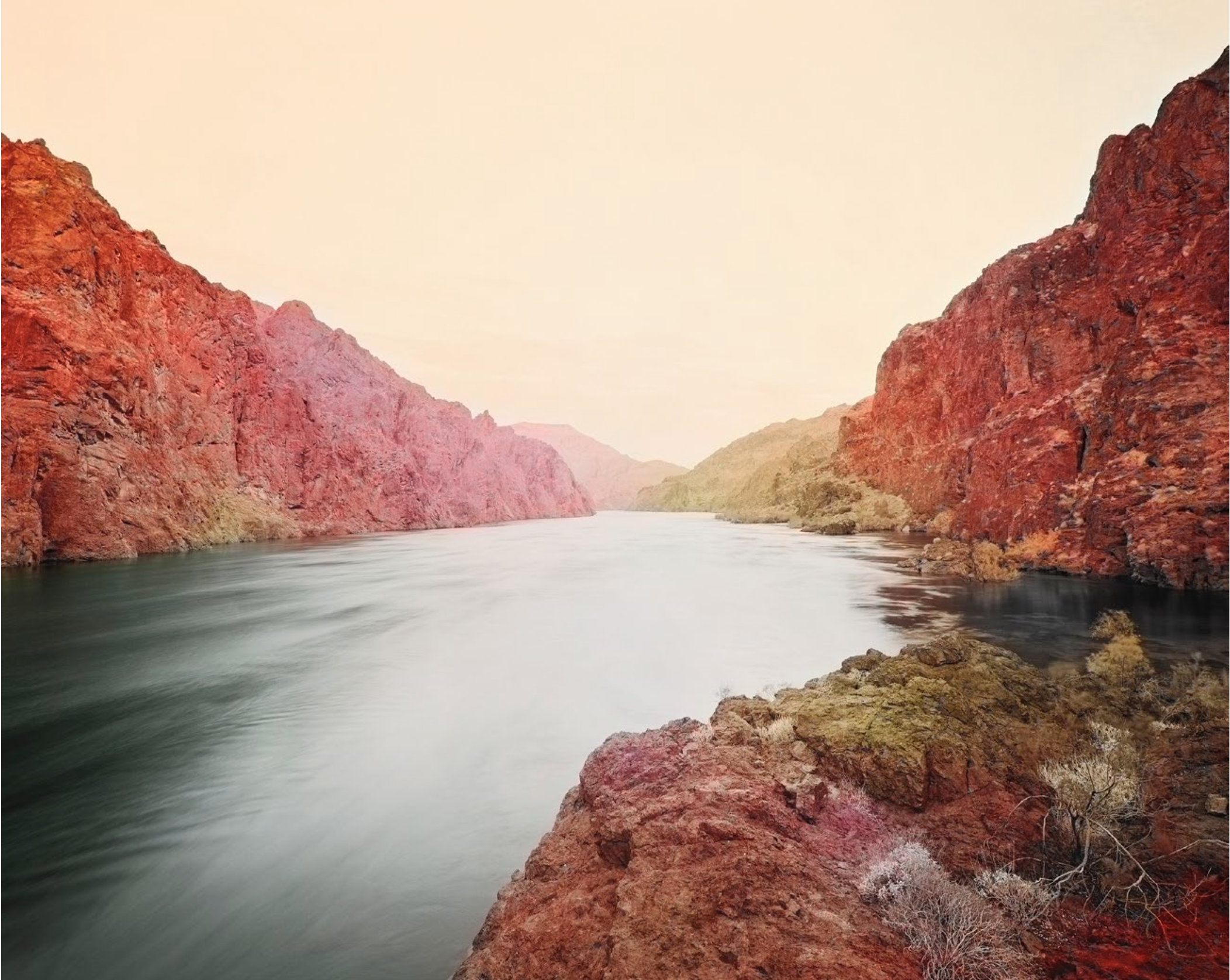
© » KADIST
Trevor Paglen
The Black Canyon Deep Semantic Image Segments by Trevor Paglen merges traditional American landscape photography (sometimes referred as ‘frontier photography’ for sites located in the American West) with artificial intelligence and other technological advances such as computer vision. In order to take this photograph, Paglen traveled to the Black Canyon, south of the Hoover Dam. Only accessible by water, Paglen piloted a boat up the Colorado river into the canyon.

© » KADIST
Miguel and Natalia Fernández de Castro and Mendoza
The Absolute Restoration of All Things is a collaboration by artist Miguel Fernández de Castro and anthropologist Natalia Mendoza. For this project, Fernández de Castro and Mendoza researched the 2014 court case that shut down Penmont Mining’s operations in the middle of the Sonoran desert. The lawsuit was brought to court by the “ejidatarios” (communal land holders) of El Bajío, Sonora, who claimed that their territory was illegally occupied and exploited, causing an irrevocable environmental impact on their land.

© » KADIST
Ei Arakawa and Sergei Tcherepnin
Part of a series entitled “Looking at Listening”, 2011, the piece invited the spectator to experiment and consider sound as a kinetic and synesthetic process, where multiple experiences and senses can cross. The presented photographs were selected from the New York Public Library and found in an archive called ‘Listening,’ with the sub-genres ‘town meetings,’ ‘investigation,’ ‘audiences 1960–1970’ and ‘conversation.’ Taking the photographs from the city’s archive of frozen moments of audio exchange, Arakawa and Tcherepnin give sound and movement back to past moments. In each of the photographs, people are listening in different situations—public, and private.

© » KADIST
John Wood and Paul Harrison
One of John Wood and Paul Harrison’s earliest works, Device features Harrison performing a series of actions, assisted by the titular ‘devices’, that use physics to force his body into unusual and uncomfortable positions. Maintaining his signature deadpan expression throughout the video, in one scene Harrison is thrusted into the air by a slowly inflating balloon until only his feet are visible in the frame, while in another he levitates in diving position with the help of a pulley system. Wood uses his body and specially-designed props created by the artist duo to explore the space of the screen in hilarious, and sometimes clumsy or violent, ways.

© » KADIST
Chantal Edie and Zacharie Ngnogue
Au non de la liberté (Tiko drink Kumba drunk) is a photographic series by Zacharie Ngnogue and Chantal Edie that considers the correlation between those who hold power in Cameroon and how their actions affect the populations they rule in often compromising ways. “Tiko drink-Kumba drunk” is an adage that is commonly used in the Southwest province of Cameroon to speak of how one’s actions affect others. Civil liberties are next to non-existent in Cameroon, the law is lawless, and structured in a way that is intended to attack its citizens’ human rights.

© » KADIST
John Lucas and Claudia Rankine
Drawing & Print (Drawing & Print)
Historically, blondeness has been a signifier for desirability and beauty, speaking to “purity” — the purity of whiteness — like no other bodily attribute except, perhaps, blue eyes. In the twenty-first century, blondeness is the look desired by American presidents, pop stars, rappers, television announcers, Hollywood celebrities, the boy next door, and some Asian Americans, African Americans, white Americans, Arab Americans, and LatinX Americans. The desirability of blonde hair has no genre boundaries, no pronoun limitation, and no class limit.
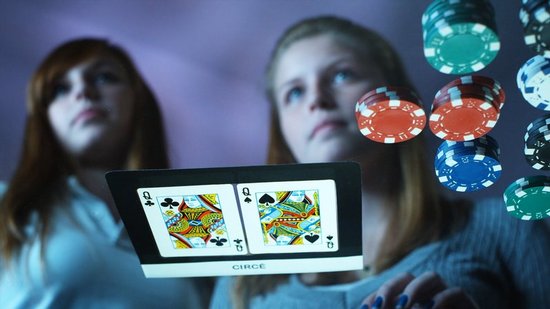
© » KADIST
Olive Martin and Patrick Bernier
The Mohawk, the emblematic Frontier river in the period of American colonisation, is here a cable of data transmission, and the 7 Sultans Casino is a virtual destination, one of the three hundred online casinos hosted by the servers located in Kahnawake, a small native american indian reserve to the south of Montreal. Incorporating poker, challenges to the law, a struggle for the control of a new territory where the stakes are high, our film ‘La Nouvelle Kahnawake’, between fiction and documentary, pushes these analogies with the Western to explore both our relationship to the figure of the ‘Indian’ and the confusion of our perception of space that new information technology has brought about. As the artists state: “We are neither anthropologists nor journalists.

© » KADIST
Maayan Amir and Ruti Sela
In Beyond Guilt the two artists create a portrait of our generation in three parts. In Tel Aviv, in confined spaces such as toilets or bar of hotel rooms, they create situations in which participants answer questions and describe themselves. Camera in hand, there is little editing in their works, leaving a rather crude result.

© » KADIST
The Propeller Group and Superflex
Fade In (the whole title of the film is actually the entire five page script) is a collaboration with the Danish artist collective Superflex (group of freelance artist–designer–activists committed to social and economic change, founded in 1993 by Jakob Fenger, Rasmus Nielsen and Bjørnstjerne Christiansen). There are several time layers to understand the story behind this film. In 1601, the San Jago set sail from Goa for Lisbon; the cargo included the first consignment of South East Asian porcelain destined for the European market.

© » KADIST
Pauline Boudry and Renate Lorenz
Salomania sees choreographer and filmmaker Yvonne Rainer and artist Wu Tsang rehearse scenes from Valda’s Solo , a chapter of a film Rainer made in 1972 after having seen women perform the dance of the seven veils in Alla Nazimova’s 1923 silent film Salomé . The script is based on the Biblical New Testament story of the Jewish princess Salomé, who in the Christian tradition has been depicted as an emblem of feminine seduction and danger. In the twentieth century, her character was made popular through English playwright Oscar Wilde’s famous theater piece, Salomé .
Gregory Halpern
Gregory Halpern is an acclaimed American photographer whose practice is predicated on wandering...
Trevor Paglen
Trevor Paglen’s work combines the knowledge-base of artist, geographer and activist...
Chantal Edie and Zacharie Ngnogue
Chantal Edie and Zacharie Ngnogue are a photography duo who channel their personal experiences into social commentaries...
Ad Minoliti
Ad Minoliti is a painter who combines the pictorial language of geometric abstraction with the perspective of queer theory...
John Wood and Paul Harrison
John Wood and Paul Harrison have been working collaboratively since 1993, producing single screen and installation-based video works...
An-My LE
- location: New York, New York
- year born: 1960
- gender: female
- home town: Saigon, Vietnam
Ho Rui An
The artist, writer, and researcher Ho Rui An probes histories of globalization and governance, performing a detournement of dominant semiotic systems across text, film, installation, and lecture...
Ana Vaz
Ana Vaz is an artist and filmmaker whose works speculate on the relationships between self and other, and myth and history, through a cosmology of signs, references, and perspectives...
Mary Ann Aitken
Mary Ann Aitken was known to be very private about her art practice; she was considered somewhat of an outsider by her peers affiliated with the second wave of Detroit’s Cass Corridor arts movement...
Leung Chi Wo and Wong Sara
Leung Chi Wo tends to highlight in his art the boundaries between viewing and voyeurism, real and fictional, and art and the everyday...
Raimond Chaves and Mantilla Gilda
The collaborative works of Raimond Chaves and Mantilla Gilda often derive from a direct engagement with the world...
Maayan Amir and Ruti Sela
Maayan Amir and Ruti Sela, two young Israeli women artists work collaboratively or individually by project...
Jane Jin Kaisen and Guston Sondin-Kung
Working with narrative experimental film, multi-channel video installation, performative video art, photography, and text, Jane Jin Kaisen engages themes of memory, trauma, migration and translation at the intersection of personal and collective histories...
Ana Navas
Ana Navas’s practice deals with the vulgarization of modern art, understanding the term vulgar in its original sense of being appropriated by common people...
Caspar Heinemann
Caspar Heinemann is a queer artist and writer who makes work that reflects and represents his gender and identity...
Musquiqui Chihying
Through his artistic career, Musquiqui Chihying has striven to dislocate and reconstruct established modes of behavior within systems and structures of power...
Jordan Ann Craig
Jordan Ann Craig is a Northern Cheyenne artist born and raised in the Bay Area; she invests her work with a strong interest in Indigenous culture and the history of its destruction by settlers...
Angela Detanico and Rafael Lain
Linguists, semiologists, and graphic designers by training, Angela Detanico and Raphaël Lain consider the use of graphic signs in society...
Jay Chung and Takeki Maeda
Jay Chung and Takeki Maeda’s practice is characterized by performance, which often involves weighty unsettling humour...
Gabriella and Silvana Mangano
Gabriella Mangano and Silvana Mangano are an artistic duo and identical twins known for their collaborative and performative video practice...
Trevor Yeung
Trevor Yeung’s (b...
The Propeller Group and Superflex
The Propeller Group was established in 2006 as a cross-disciplinary structure...
Tun Win Aung and Wah Nu
Wah Nu and Tun Win Aung, respectively born in 1977 and 1975, Yangon, Myanmar...
Pooja Gurung and Bibhusan Basnet
Pooja Gurung and Bibhusan Basnet have a joint practice that merges film and visual art...
Asier Mendizabal
Asier Mendizabal explores political subjects and their symbols...
Christine Sun Kim and Thomas Mader
Christine Sun Kim and Thomas Mader have been collaborating for the last 5 years, covering communication in a variety of formats such as recording an overnight shipment from Berlin to New York ( Recording Contract , 2013), compiling 24 hours of invited contributors’ studio time ( Busy Day , 2014), and using the arm game, a combination of body and face, in order to describe a series awkward situations ( Classified Digits , 2016)....
Gregory Crewdson
- location: New York, New York
- year born: 1962
- gender: male
- nationality: American
- home town: Brooklyn, New York
John Lucas and Claudia Rankine
John Lucas and Claudia Rankine are interdisciplinary thinkers and makers committed to exploring the nuances of race and power in our daily lives...
Etel Adnan and Lynn Marie Kirby
Visual artist, poet, and essayist Etel Adnan writes what must be communicated through language, and paints what cannot...

© » APERTURE
about 3 months ago (01/17/2024)
The photographer speaks with his brother, the journalist Jake Halpern, about growing up in a city of surreal sights and memorable characters....

© » APERTURE
about 5 months ago (12/01/2023)
For the past two decades, An-My Lê has used photography to examine her personal history and the legacies of US military power, probing the tension between experience and storytelling....
-
1980-1989
Jean-Marie Straub and Danièle Huillet
1982En rachâchant is based on the short story Ah! Ernesto! (1971) by Marguerite Duras in which the child Ernesto does not want to go to school anymore as all that he is taught are things he does not know...
-
1990-1999
John Wood and Paul Harrison
1996One of John Wood and Paul Harrison’s earliest works, Device features Harrison performing a series of actions, assisted by the titular ‘devices’, that use physics to force his body into unusual and uncomfortable positions...
John Wood and Paul Harrison
19973-Legged is an early video work by John Wood and Paul Harrison in which they appear with their legs tied together (as one would do in a three-legged race)...
-
2000-2009
Mary Ann Aitken
2002Untitled (Boom Box, Double-Sided) by Mary Ann Aitken is representational painting of a boom box on an unconventionally long canvas painted on both sides, to mimic the scale and appearance of the actual appliance...
Maayan Amir and Ruti Sela
2003In Beyond Guilt the two artists create a portrait of our generation in three parts...
Gregory Crewdson
2005Forest Gathering N.2 is part of the series of photographs Beneath the Roses (2003-2005) where anonymous townscapes, forest clearings and broad, desolate streets are revealed as sites of mystery and wonder; similarly, ostensibly banal interiors become the staging grounds for strange human scenarios...
Barbara Kasten
2008Barbara Kasten’s Studio Construct 51 depicts an abstract still life: a greyscale photograph of clear translucent panes assembled into geometric forms, the hard lines of their edges converging and bisecting at various points...
Pauline Boudry and Renate Lorenz
2009Salomania sees choreographer and filmmaker Yvonne Rainer and artist Wu Tsang rehearse scenes from Valda’s Solo , a chapter of a film Rainer made in 1972 after having seen women perform the dance of the seven veils in Alla Nazimova’s 1923 silent film Salomé ...
Jay Chung and Takeki Maeda
2009Jay Chung and Q Takeki Maeda remake a clip from the 1970s they found on the internet, and without really changing this archive material, displace it by imitating the staging and the acting with scrupulous precision...
Mary Ann Aitken
2009Untitled (Diptych) by Mary Ann Aitken is a pair of paintings; one entirely abstract and the other a hybrid of representational and abstract elements...
-
2010-2019
Olive Martin and Patrick Bernier
2010The Mohawk, the emblematic Frontier river in the period of American colonisation, is here a cable of data transmission, and the 7 Sultans Casino is a virtual destination, one of the three hundred online casinos hosted by the servers located in Kahnawake, a small native american indian reserve to the south of Montreal...
The Propeller Group and Superflex
2010Fade In (the whole title of the film is actually the entire five page script) is a collaboration with the Danish artist collective Superflex (group of freelance artist–designer–activists committed to social and economic change, founded in 1993 by Jakob Fenger, Rasmus Nielsen and Bjørnstjerne Christiansen)...
Leung Chi Wo and Wong Sara
2010Office Lady with a Red Umbrella restages a figure from a 1980 postcard made from a photograph from 1950’s...
Jane Jin Kaisen and Guston Sondin-Kung
2010The Woman, The Orphan, and The Tiger begins with the sound of women’s voices describing histories of violence, of things repressed and silenced...
Leung Chi Wo and Wong Sara
2010Photojournalist with Two Cameras restages a portrait of a photojournalist from the background of an old photograph of protest published in South China Morning Post on January 10, 2010 under the headline “Return of the Radicals: Recent angry protests are nothing new.” The photojournalist in the photograph, probably from a protest of earlier decades, was capturing the scene of a protester’s arrest while wearing two cameras...
An-My LE
2010The print Patient Admission, US Naval Hospital Ship Mercy, Vietnam (2010) features an Asian Buddhist monk and an American Navy Solider on board the Mercy ship –one of the two dedicated hospital ships of the United States Navy– sitting upright in their chairs and adopting the same posture...
Võ An Khánh
2010In Extra Curriculum Political Science Class 7/1972 , a group of women walk bare-foot and single file towards Dat Mui Mangrove in Ca Mau Province to attend ‘political science class’...
Ei Arakawa and Sergei Tcherepnin
2011Part of a series entitled “Looking at Listening”, 2011, the piece invited the spectator to experiment and consider sound as a kinetic and synesthetic process, where multiple experiences and senses can cross...
Tun Win Aung and Wah Nu
2011Tun Win Aung and Wah Nu initiated the series 1000 Pieces (of White) in 2009, as a way to produce objects and images as a portrait of their shared life as partners and collaborators...
Ana Teresa Fernández
Drawing & Print
2011(Drawing & Print) The artist writes about her work Borrando la Frontera, a performance done at Tijuana/San Diego border: “I visually erased the train rails that serve as a divider between the US and Mexico...
Asier Mendizabal
2012Rotation presents the image of a crowd, a re-appropriation of 19th or beginning of 20th century photographs published in newspapers and magazines...
Ana Roldán
2012Ana Roldán’s Primeval forms series looks up close at the fecund shapes of plants often found in the artist’s native Mexico...
Ana Roldán
2012Ana Roldán’s Displacements works use images taken from a 1970s exhibition catalogue for an exhibition called The Death in Mexico...
Donna Conlon and Jonathan Harker
2012In Tapitapultas (2012), Donna Conlon and Jonathan Harker comment on mass consumerism and pollution by way of a game they invented...
Trevor Yeung
2014“We both died at the same moment” is a humorous observation of anthropomorphism, the attribution of human emotions to nature and animals...
Gabriella and Silvana Mangano
2015There is no there by Gabriella and Silvana Mangano is a black and white looped video with sound, in conjunction with a live performance...
João Maria Gusmão and Pedro Paiva
2015The artist duo João Maria Gusmão and Pedro Paiva traveled to Japan for a month to make a series of short 16mm films, often shot in slow-motion...
Gregory Halpern
2016Gregory Halpern spent five years shooting ZZYZX , and another year editing the results, from an estimated thousand rolls of film, about half of which were shot in the final year after his Guggenheim Fellowship enabled him to live in California...
Gregory Halpern
2016Gregory Halpern spent five years shooting ZZYZX , and another year editing the results, from an estimated thousand rolls of film, about half of which were shot in the final year after his Guggenheim Fellowship enabled him to live in California...
Gregory Halpern
2016Gregory Halpern spent five years shooting ZZYZX , and another year editing the results, from an estimated thousand rolls of film, about half of which were shot in the final year after his Guggenheim Fellowship enabled him to live in California...
Gregory Halpern
2016Gregory Halpern spent five years shooting ZZYZX , and another year editing the results, from an estimated thousand rolls of film, about half of which were shot in the final year after his Guggenheim Fellowship enabled him to live in California...
Gregory Halpern
2016Gregory Halpern spent five years shooting ZZYZX , and another year editing the results, from an estimated thousand rolls of film, about half of which were shot in the final year after his Guggenheim Fellowship enabled him to live in California...
Gregory Halpern
2016Gregory Halpern spent five years shooting ZZYZX , and another year editing the results, from an estimated thousand rolls of film, about half of which were shot in the final year after his Guggenheim Fellowship enabled him to live in California...
Gregory Halpern
2016Gregory Halpern spent five years shooting ZZYZX , and another year editing the results, from an estimated thousand rolls of film, about half of which were shot in the final year after his Guggenheim Fellowship enabled him to live in California...
Gregory Halpern
2016Gregory Halpern spent five years shooting ZZYZX , and another year editing the results, from an estimated thousand rolls of film, about half of which were shot in the final year after his Guggenheim Fellowship enabled him to live in California...
Gregory Halpern
2016Gregory Halpern spent five years shooting ZZYZX , and another year editing the results, from an estimated thousand rolls of film, about half of which were shot in the final year after his Guggenheim Fellowship enabled him to live in California...
Gregory Halpern
2016Gregory Halpern spent five years shooting ZZYZX , and another year editing the results, from an estimated thousand rolls of film, about half of which were shot in the final year after his Guggenheim Fellowship enabled him to live in California...
Christine Sun Kim and Thomas Mader
2016Indexes that either allow or inhibit the establishment of communication exist in both signed as well as spoken languages...
Trevor Paglen
2017Trevor Paglen’s ongoing research focuses on artificial intelligence and machine vision, i.e...
Etel Adnan and Lynn Marie Kirby
Drawing & Print
2017(Drawing & Print) In conjunction with KADIST’s 2017 exhibition If Not Apollo, the Breeze , artist and filmmaker Lynn Marie Kirby performed Transmissions , a video and live reading created with longtime collaborator Etel Adnan...
John Lucas and Claudia Rankine
Drawing & Print
2018(Drawing & Print) Historically, blondeness has been a signifier for desirability and beauty, speaking to “purity” — the purity of whiteness — like no other bodily attribute except, perhaps, blue eyes...
Pooja Gurung and Bibhusan Basnet
2018DADYAA: The Woodpeckers of Rotha by Pooja Gurung and Bibhusan Basnet illuminates a unique and seldom seen international perspective on indigenous cultures and contemporary social issues in the Nepali context...
Musquiqui Chihying and Gregor Kasper
2019Addressing the legacy of colonialism, The Guestbook by Musquiqui Chihying and Gregor Kasper is a slow-paced, black-and-white film exploring the German colony of Togoland, now the Republic of Togo...
Musquiqui Chihying
2019The Sculpture by Musquiqui Chihying comprises a two-channel lecture performance and a photograph...
Ana María Millán
2019Interested in role-play and videogames, Ana María Millán developed workshops with different communities in order to create characters and scenarios for her animations, often in collaboration with a choreographer...
Ad Minoliti
2019In Ad Minoliti’s expansive three-panel painting Abstracción geométrico-galáctica the artist’s hallmark geometric abstractions serve as playful substitutes for more straightforward depictions of the world...
Jordan Ann Craig
2019Something To Do With Being Held by Jordan Ann Craig is inspired by a Cheyenne bead bag...
-
2020-2029
Trevor Paglen
2020Half Dome Hough Transform by Trevor Paglen merges traditional American landscape photography (sometimes referred as ‘frontier photography’ for sites located in the American West) with artificial intelligence and other technological advances such as computer vision...
Trevor Paglen
2020The Black Canyon Deep Semantic Image Segments by Trevor Paglen merges traditional American landscape photography (sometimes referred as ‘frontier photography’ for sites located in the American West) with artificial intelligence and other technological advances such as computer vision...
Chantal Edie and Zacharie Ngnogue
2020Au non de la liberté (Tiko drink Kumba drunk) is a photographic series by Zacharie Ngnogue and Chantal Edie that considers the correlation between those who hold power in Cameroon and how their actions affect the populations they rule in often compromising ways...
Chantal Edie and Zacharie Ngnogue
2020Au non de la liberté (Tiko drink Kumba drunk) is a photographic series by Zacharie Ngnogue and Chantal Edie that considers the correlation between those who hold power in Cameroon and how their actions affect the populations they rule in often compromising ways...
Chantal Edie and Zacharie Ngnogue
2020Au non de la liberté (Tiko drink Kumba drunk) is a photographic series by Zacharie Ngnogue and Chantal Edie that considers the correlation between those who hold power in Cameroon and how their actions affect the populations they rule in often compromising ways...
Jonas Van and Juno B
2021Jonas Van and Juno B’s video work Kebranto is anchored by the figure of Boitatá, a snake that is part of the imaginary Guaraní communities that live between the current nation-states of Argentina, Brazil, Paraguay, and Uruguay...
Caspar Heinemann
2022Glorie #7 by Caspar Heinemann is made from cardboard boxes in which the artist received deliveries at home during lockdown, as well as other materials that he uses in an improvisatory way...
Miguel and Natalia Fernández de Castro and Mendoza
2022The Absolute Restoration of All Things is a collaboration by artist Miguel Fernández de Castro and anthropologist Natalia Mendoza...
Köken Ergun and Satyam Mishra
2022Nepal and China signed an agreement for the Belt and Road Initiative (BRI) in 2017...
Ana Vaz
2022Ana Vaz describes her film É Noite na América (It is Night in America) as an eco-terror tale, freely inspired by A cosmopolitics of animals by Brazilian philosopher Juliana Fausto; in which she investigates the political life of non-human beings and questions the modern idea of the exceptionality of the human species...
Michelle and Noel Keserwany
2022Les Chenilles by Michelle and Noël Keserwany is a sensual film that translates the source of women’s oppression into the means for their liberation...
Köken Ergun and Tashi Lama
2022Nepal and China signed an agreement for the Belt and Road Initiative (BRI) in 2017...
Köken Ergun and Satyam Mishra
2022Nepal and China signed an agreement for the Belt and Road Initiative (BRI) in 2017...
Lenka Clayton and Phillip Andrew Lewis
2022Five Hundred Twenty-Four, a single-channel video installation by Lenka Clayton and Phillip Andrew Lewis, features singers from over twenty Cleveland-area choirs counting numbers in an iterative process: one person sings “one”, then two people sing “two”, and so forth, to 524...








